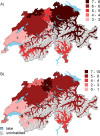Large regional variation in cardiac closure procedures to prevent ischemic stroke in Switzerland a population-based small area analysis
- PMID: 38166018
- PMCID: PMC10760725
- DOI: 10.1371/journal.pone.0291299
Large regional variation in cardiac closure procedures to prevent ischemic stroke in Switzerland a population-based small area analysis
Abstract
Background: Percutaneous closure of a patent foramen ovale (PFO) or the left atrial appendage (LAA) are controversial procedures to prevent stroke but often used in clinical practice. We assessed the regional variation of these interventions and explored potential determinants of such a variation.
Methods: We conducted a population-based analysis using patient discharge data from all Swiss hospitals from 2013-2018. We derived hospital service areas (HSAs) using patient flows for PFO and LAA closure. We calculated age-standardized mean procedure rates and variation indices (extremal quotient [EQ] and systematic component of variation [SCV]). SCV values >5.4 indicate a high and >10 a very high variation. Because the evidence on the efficacy of PFO closure may differ in patients aged <60 years and ≥60 years, age-stratified analyses were performed. We assessed the influence of potential determinants of variation using multilevel regression models with incremental adjustment for demographics, cultural/socioeconomic, health, and supply factors.
Results: Overall, 2574 PFO and 2081 LAA closures from 10 HSAs were analyzed. The fully adjusted PFO and LAA closure rates varied from 3 to 8 and from 1 to 9 procedures per 100,000 persons per year across HSAs, respectively. The regional variation was high with respect to overall PFO closures (EQ 3.0, SCV 8.3) and very high in patients aged ≥60 years (EQ 4.0, SCV 12.3). The variation in LAA closures was very high (EQ 16.2, SCV 32.1). In multivariate analysis, women had a 28% lower PFO and a 59% lower LAA closure rate than men. French/Italian language areas had a 63% lower LAA closure rate than Swiss German speaking regions and areas with a higher proportion of privately insured patients had a 86% higher LAA closure rate. After full adjustment, 44.2% of the variance in PFO closure and 30.3% in LAA closure remained unexplained.
Conclusions: We found a high to very high regional variation in PFO closure and LAA closure rates within Switzerland. Several factors, including sex, language area, and insurance status, were associated with procedure rates. Overall, 30-45% of the regional procedure variation remained unexplained and most probably represents differing physician practices.
Copyright: © 2024 Stoller et al. This is an open access article distributed under the terms of the Creative Commons Attribution License, which permits unrestricted use, distribution, and reproduction in any medium, provided the original author and source are credited.
Conflict of interest statement
The authors declare no additional funding or competing interests such as consultancies, stock ownership or other payments other than the reported funding sources. Dr. Haynes is affiliated with CTU Bern, University of Bern, which has a staff policy of not accepting honoraria or consultancy fees. However, CTU Bern is involved in design, conduct, or analysis of clinical studies funded by not-for-profit and for-profit organizations. In particular, pharmaceutical and medical device companies provide direct funding to some of these studies. For an up-to-date list of CTU Bern’s conflicts of interest see http://www.ctu.unibe.ch/research/declaration_of_interest/index_eng.html. This does not alter our adherence to PLOS ONE policies on sharing data and materials.
Figures


Similar articles
-
Regional variation and temporal trends in transcatheter and surgical aortic valve replacement in Switzerland: A population-based small area analysis.PLoS One. 2024 Jan 8;19(1):e0296055. doi: 10.1371/journal.pone.0296055. eCollection 2024. PLoS One. 2024. PMID: 38190381 Free PMC article.
-
Regional variation in hip and knee arthroplasty rates in Switzerland: A population-based small area analysis.PLoS One. 2020 Sep 21;15(9):e0238287. doi: 10.1371/journal.pone.0238287. eCollection 2020. PLoS One. 2020. PMID: 32956363 Free PMC article.
-
High regional variation in prostate surgery for benign prostatic hyperplasia in Switzerland.PLoS One. 2021 Jul 22;16(7):e0254143. doi: 10.1371/journal.pone.0254143. eCollection 2021. PLoS One. 2021. PMID: 34292959 Free PMC article.
-
Cardiac procedures to prevent stroke: patent foramen ovale closure/left atrial appendage occlusion.Can J Cardiol. 2014 Jan;30(1):87-95. doi: 10.1016/j.cjca.2013.11.008. Epub 2013 Nov 15. Can J Cardiol. 2014. PMID: 24365193 Review.
-
The Case for Selective Patent Foramen Ovale Closure After Cryptogenic Stroke.Circ Cardiovasc Interv. 2018 Mar;11(3):e004152. doi: 10.1161/CIRCINTERVENTIONS.117.004152. Circ Cardiovasc Interv. 2018. PMID: 29870380 Review.
Cited by
-
Enhancing Cardiovascular Risk Prediction: Development of an Advanced Xgboost Model with Hospital-Level Random Effects.Bioengineering (Basel). 2024 Oct 18;11(10):1039. doi: 10.3390/bioengineering11101039. Bioengineering (Basel). 2024. PMID: 39451414 Free PMC article.
-
Rethinking the Impact of Single Continuing Educational Activities: Navigating Complexity Through Insights from Real-World Evaluation and Contemporary Literature.J CME. 2025 May 12;14(1):2498292. doi: 10.1080/28338073.2025.2498292. eCollection 2025. J CME. 2025. PMID: 40370806 Free PMC article.
References
-
- Kitsios G, Dahabreh I, Abu Dabrh A, Thaler D, Kent D. Patent foramen ovale closure and medical treatments for secondary stroke prevention: a systematic review of observational and randomized evidence. Stroke. 2012;43(2):422–31. Epub 2011/12/20. doi: 10.1161/STROKEAHA.111.631648 ; PubMed Central PMCID: PMC3342835. - DOI - PMC - PubMed

